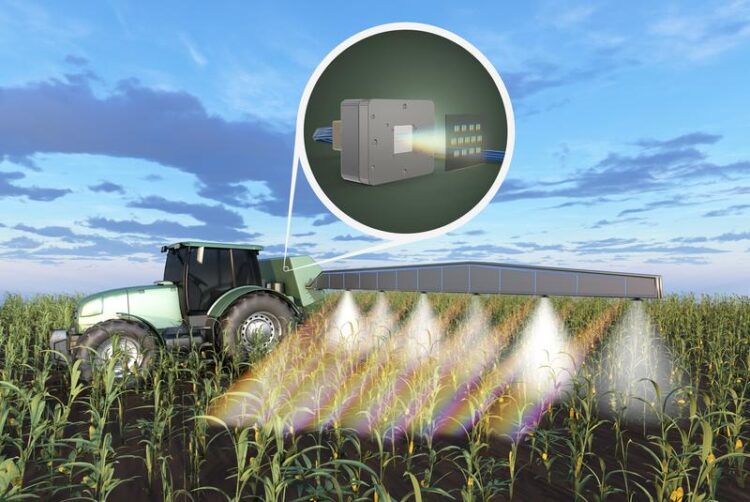Flexible microspectrometer for mobile applications

Thanks to its compact design, the microspectrometer is robust and can be easily integrated even in demanding environments. Here is an exemplary visualization for use in agriculture
© Fraunhofer IOF
Researchers at the Fraunhofer Institute for Applied Optics and Precision Engineering IOF have developed a very compact spectrometer module. It maps spectra from 39 optical fibers onto one camera sensor in a small space. This is made possible by a special micro-optical system. The technology, which has potential for applications in quality assurance and analytics, will be presented at analytica trade fair in Munich from April 9 to 12.

The fiber-coupled microspectrometer array maps 39 spectra onto a CMOS sensor. © Fraunhofer IOF
If you want to spectrally analyze the light from many distant measuring points, you can either use several separate micro spectrometers or complex laboratory equipment. Neither is an option when it comes to flexible or even mobile applications. A team from Fraunhofer IOF has now developed a solution in which light is flexibly guided to a single, very compact optical system using 39 optical fibers. This maps the spectral information onto the image sensor of a camera.
Micro-optics for spectrometer array
At this year’s analytica trade fair, Fraunhofer IOF is presenting a demo system with the new spectrometer optics at booth A3.407. However, not much of it can be seen – because it is so small. The researchers from Jena have developed a special micro-optical system for processing the light transmitted via optical fibers. It consists of many spectrometers arranged next to each other, forming what is called as a spectrometer array.
Each channel contains a prism-grating-prism arrangement between achromatic micro lenses. The micro lenses are separated by spacers to prevent crosstalk between the channels. This array arrangement allows to mount all spectrometer channels at once and results in an optical system length of less than two centimeters.
Despite the limited dimensions, the system maps the spectrum from around 400 to 800 nanometers. A resolution of 0.6 nanometers per pixel is achieved with the corresponding CMOS sensor.
Compact optics for quality assurance and analytics
The technology has been developed for applications where spectral measurements are required at many positions or over large areas. This applies, for example, to the optical analysis of coatings or printings, to parallel measurements in bioanalytics as well as to digital agriculture, e.g., to check the health status of plants. Thanks to the integrated design, the setup is robust and can be integrated into existing systems easily.
The team from Fraunhofer IOF has developed the technology to application maturity over three years with the support of the Thüringer Aufbaubank. The task now is to optimize it for specific applications with the appropriate partners. For example, the spectral resolution could be adjusted, or the spectral measuring range can be extended to 1,600 nanometers – even different parameters of the channels are conceivable.
Presentation at analytica 2024
The Fraunhofer IOF team will be presenting the compact micro spectrometer at this year’s analytica trade fair in Munich from April 9 to 12 at the Fraunhofer booth A3.407.
About Fraunhofer IOF
The Fraunhofer Institute for Applied Optics and Precision Engineering IOF in Jena conducts application-oriented research in the field of photonics and develops innovative optical systems for controlling light – from its generation and manipulation to its application. The institute’s range of services covers the entire photonic process chain from opto-mechanical and opto-electronic system design to the production of customer-specific solutions and prototypes. At Fraunhofer IOF, around 500 employees work on the annual research volume of 40 million euros.
For more information about Fraunhofer IOF, please visit: http://www.iof.fraunhofer.de
Wissenschaftliche Ansprechpartner:
Dr. Norbert Danz
Fraunhofer IOF
Department Optical and Mechanical System Design
Phone: +49 (0) 3641 807 – 750
Mail: norbert.danz@iof.fraunhofer.de
Weitere Informationen:
https://www.iof.fraunhofer.de/en/pressrelease/2024/microspectrometer.html
Media Contact
All latest news from the category: Physics and Astronomy
This area deals with the fundamental laws and building blocks of nature and how they interact, the properties and the behavior of matter, and research into space and time and their structures.
innovations-report provides in-depth reports and articles on subjects such as astrophysics, laser technologies, nuclear, quantum, particle and solid-state physics, nanotechnologies, planetary research and findings (Mars, Venus) and developments related to the Hubble Telescope.
Newest articles

Innovative 3D printed scaffolds offer new hope for bone healing
Researchers at the Institute for Bioengineering of Catalonia have developed novel 3D printed PLA-CaP scaffolds that promote blood vessel formation, ensuring better healing and regeneration of bone tissue. Bone is…

The surprising role of gut infection in Alzheimer’s disease
ASU- and Banner Alzheimer’s Institute-led study implicates link between a common virus and the disease, which travels from the gut to the brain and may be a target for antiviral…

Molecular gardening: New enzymes discovered for protein modification pruning
How deubiquitinases USP53 and USP54 cleave long polyubiquitin chains and how the former is linked to liver disease in children. Deubiquitinases (DUBs) are enzymes used by cells to trim protein…


